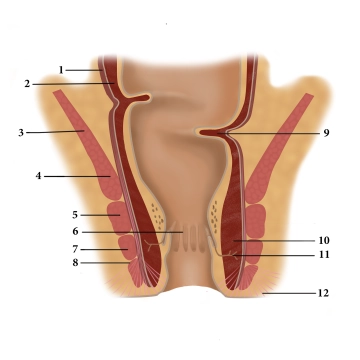(1) Tunica muscularis, longitudinal sublayer, (2) Tunica muscularis, circular sublayer, (3) levator ani, (4) puborectalis, (5) external anal sphincter, deep part, (6) anal columns, (7) external anal sphincter, superficial part, (8) external anal sphincter, subcutaneous part, (9) Kohlrausch’s fold, (10) internal anal sphincter, (11) proctodeal gland, (12) corrugator cutis ani
Rectum
From a functional point of view, the rectum is a storage reservoir for feces preventing its continuous discharge. The rectum directly adjoins the sigmoid colon and resembles it in that it has an S-shaped anteroposterior and lateral curvature (sacral, anorectal and sacral flexure). Typically, the rectum is divided into three segments:
- Rectal ampulla (main reservoir, anterior to the sacrum)
- Anal canal (see below, sealing zone between the anorectal flexure and the cutaneous orifice)
- Between 1. and 2. an unspecified section which emerges perpendicularly from 1. and joins 2., also at right angles. Here, the mucosa presents with typical folds (Kohlrausch's folds).
Posteriorly the rectum is related to the sacrum and coccyx, laterally to the internal iliac arteries and veins, regional lymph nodes, sacral plexus and parts of the autonomic nervous system, as well as both ureters and uterine adnexa. In the female, the uterus and vagina lie anteriorly, while in men this is true for the bladder and prostate/seminal vesicles. Inferiorly the rectum is related to the pelvic floor.
Anal canal
- The interaction of three muscles in the lower rectum creates a sphincter mechanism:
- The internal anal sphincter represents a thickening of the last annular fibers of the smooth colon muscles and is innervated by the sympathetic nervous system
- The levator ani, however, has voluntary innervation (sacral plexus) and includes the puborectalis arising from the symphysis pubis. Since the course of the puborectalis creates a sling (deficient anteriorly) around the rectum, the latter becomes angulated.
The external anal sphincter is also a striated muscle and extends from the center of the perineum (centrum perinei, perineal body) to the coccyx. Its somatic innervation is supplied by the pudendal nerve. With its contraction it completely seals off the anal canal.
The different innervation of the three muscles involved in the sphincter mechanism provides additional protection against failure and resulting incontinence.
The mucosa of the anal canal is plicated into numerous longitudinal folds (anal columns) displaying a dense arterial (!) plexus with venous drainage. When the sphincter muscles contract, these plexuses fill up quickly distending the mucosa and pushing the folds against each other, thereby ensuring a gas-tight seal. Hemorrhoids and venous thromboses are well known vascular complications in this region.
Defecation involves not only relaxation of the sphincter mechanisms (initiated by voluntary muscle action, drainage of the cavernous bodies) but also active abdominal press and intestinal peristalsis.
Blood supply
Three main arteries supply the rectum with blood:
- Superior rectal artery (from the inferior mesenteric artery) via the sigmoid mesocolon (Caution: Transection of this artery at the level of the sigmoid colon results in ischemia of the upper rectum!)
- Medial rectal artery (from the internal iliac artery), coursing craniad of the levator ani
- Inferior rectal artery (from the internal pudendal artery) inferior to the levator ani.
Venous drainage is via the venous rectal plexus underneath the mucosa of the rectum. The superior rectal vein drains the blood of the upper rectum via the inferior mesenteric vein into the liver, while the medial and inferior rectal veins drain the blood of the middle and lower rectum via the internal iliac vein into the lower vena cava (portocaval anastomosis). Medications administered as suppositories therefore only enter the body without being metabolized, if they are not advanced up into the region drained by the superior rectal vein.
Lymphatic drainage of the rectum parallels the rectal blood vessels: The large cluster of inferior mesenteric lymph nodes forms a separate group at the upper rectum (superior rectal lymph nodes); the internal iliac lymph nodes filter lymph from the middle rectum (from the pararectal lymph nodes) and the superficial inguinal lymph nodes from the lower anal region, anus and perineal skin.
Perineum
The perineum includes the region inferior to the pelvic diaphragm (genitourinary and anal region) and is delimited:
- Craniad by the fascia of the inferior pelvic diaphragm
- Anteriorly by the symphysis pubis
- Laterally by the ischium
- Posteriorly by the inferior edge of the gluteus maximus.
The posterior perineum corresponds to the anal region and is known in the nomenclature as ischioanal fossa, while the anterior perineum corresponds to the pubic region and can itself be divided into three segments lying on top of each other: At the most superficial level a subcutaneous perineal pouch (Colles space) (between the stratum membranosum telae subcutaneae perinei = Colles fascia and the perineal fascia), a superficial perineal pouch between the perineal fascia and perineal membrane (Buck), and a deep perineal pouch superior to the perineal membrane.
Below the skin the posterior ischioanal fossa consists mainly of fatty tissue and numerous vessels/nerves (branches of the inferior rectal and internal pudendal artery and the pudendal nerve to the anal region). At the transition to the sacral region, a space lined with epithelium may develop in the gluteal fold and form a sinus between the tip of the coccyx and the anal verge. It may be encapsulated like a cyst (dermoid cyst) or have an external orifice (pilonidal sinus).
The anterior superficial perineal space comprises the superficial muscles of the perineum and the blood vessels and nerves to the external genitals (perineal artery and artery of bulb of vestibule, as well as branches of the pudendal nerve to the labia/clitoris and scrotum respectively).
The deep anterior perineal space is less clearly delimited, merges with the ischioanal fossa posteriorly and comprises the deep perineal muscles and other deep vessels/nerves.
